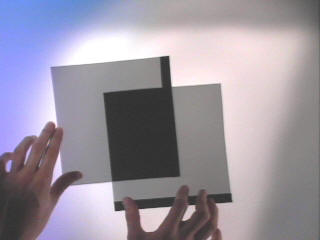|
Polarization
An optical polarizer is a material that takes random, multi-directional light and allows light vibrating in only one plane to
be transmitted. An analyzer is a second polarizer that is used to test the orientation of the transmitted light.
Polaroid filters
transmit 50% of unpolarized light. In the following
animation, feel free to rotate the polaroids located between the light
source and the 35-mm camera. In the animation, the lines on the polaroid
show the axis of the polaroid. When the axes of the polaroids are at a
right angle, all light is depleted. At the angles between 90º and 270º, the
change in the degree of the angle alters the amount of light passed through to
the camera.

Image courtesy of the
University of Montana
The next applicable demonstration shows a
polarizing filter
and its effects in photography. A polarizing filter is used as an analyzer and, when correctly aligned, create images that are clearer and more colorful.
To use this animation, click the picture at any location to move the lens to
that area. By clicking inside the lens (circle), holding the button down
and moving the mouse, you cause the lens to rotate, changing the amount of light
allowed through the lens. The actual relative direction corresponds to the
pair of sunglasses in the top left corner of the picture.
Glare is often defined as horizontally polarized light that has been
reflected off a nearby surface. This light is easily blocked with a
vertically polarized analyzer usually in the form of polaroid sunglasses. Our
desire is to remove the need for sunglasses by stopping the transmission of the
glare to the driver by treating the windshield with a nano-optical film that
allows sufficient ambient light to meet ANSI/SAE standards.
In 2004, D.R. Solli and J.M. Hickmann showed that the "polarization of electromagnetic radiation could be completely controlled using devices constructed entirely from photonic crystals." Later in 2006, Robert Norwood of the University of Arizona stated that "photonic crystals have now started to make the transition from basic to applied research."
|
 Product
Product
 Liquid Crystals
Liquid Crystals Moth-eye Gratings
Moth-eye Gratings Photonic Crystals
Photonic Crystals Laws
Laws
 Manufacturing
Manufacturing
